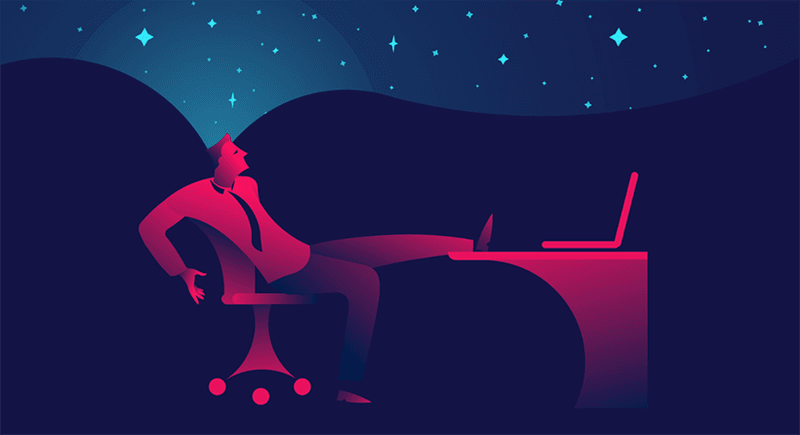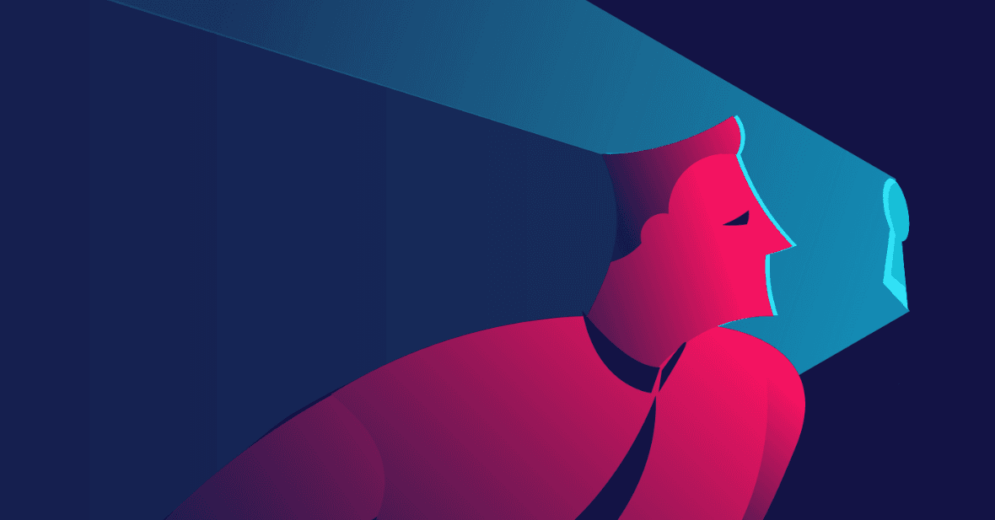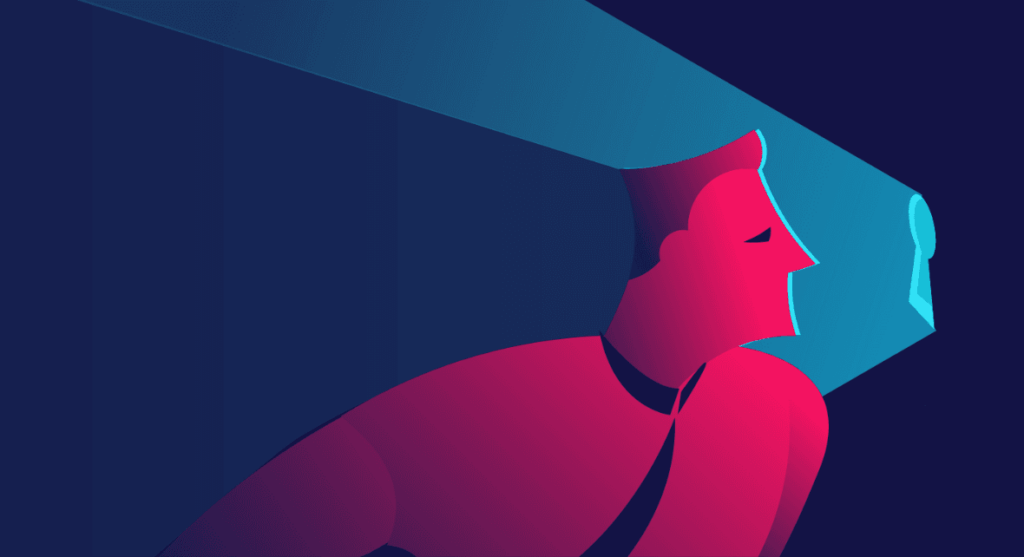A curious person can often be called a bore for asking many questions and trying to understand how the world works. But on the contrary, curiosity is very important in our lives. We open our minds and try to learn about anything we want through curiosity.
As such, this characteristic is essential for a career in UX Design. And not only in the beginning but throughout their lives.
Keep reading to understand how curiosity is essential to your UX design career!
The importance of curiosity in UX

The field of UX Design is multidisciplinary. It involves knowledge about psychology, marketing, business, people management, technology, logic, and much more.
Thus, it is fundamental that the professional who intends to work or already works as a Product Designer always maintains a mindset of curiosity to learn about the most diverse subjects.
This mindset will also lead us to ask clarifying questions, listen more actively to the answers, and consequently get more involved in the problems. Moreover, curiosity also allows us to develop creativity, which enables the innovation process, essential in UX Design.
In this sense, we can go further and say that curiosity is the root of intelligence.
When we work with UX Design, we need all this mentality of searching for the root of a problem, understanding the reason for each situation, and mainly, not accepting the first answer we find, because we need to go deeper and question more, to learn about the most diverse areas.
Reading Tip: Product Manager – Business, Technology, and User Experience
The role of curiosity throughout the UX Designer's career
Curiosity should not be present only in the beginning of a career. Quite the contrary.
Being curious is essential and has several benefits depending on what moment of life you are in.
1) For those who are pivoting
It's essential to be curious. In fact, it's necessary to be very curious.
Not only to understand what UX is but also to know the possibilities of work in the area, tools, methodologies, and project development. In addition, it's important to be curious to know what skills are needed to succeed.
To get the answers to these questions, you must ask them and be curious about them.
At this point, it is necessary to remember Socrates, the old Greek philosopher and author of the famous phrase, "I know that I know nothing."
Socrates always answered a question with another question. As he searched for answers, new questions came up, which became a circle until he concluded that the more knowledge he had, the less he knew.
So the professionals who are migrating to UX Design should humbly put themselves in a position of learning. In this way, the more questions arise, the more answers will appear, the cycle begins again, and consequently, the constant expansion of knowledge takes place.
We will leave here some tips for reading articles that can help you in this transition phase:
- Pivoting Your Career: What Is UX Design?
- UX Design In High Demand
- Why Is Empathy Essential For UX Design?
- Problem Investigation In UX Design
2) For those just starting out in their careers
It's essential to ask the why of things, especially when you are starting out as a UX professional.
In this respect, one should not be ashamed or afraid to ask a lot, and it's necessary to ask a lot indeed.
This is the good thing about being a Junior Designer because this is the time when there is little pressure and a lot of predisposition to learning and mentoring. Think that a Junior Designer is like a curious child. He is discovering everything, and cannot be left with doubts or settle for a simple "just because".
A professional who knows how to take advantage of the beginning of their career to ask countless questions will certainly be distinguished and will advance more quickly in their career. Therefore, don't be afraid to ask questions and to make mistakes, because that is how the learning process happens.
So, besides curiosity, know that making mistakes is normal and part of the process. Contrary to what one might think, making mistakes will not hinder your development, quite the contrary.
We need to be open to not knowing, to learning, to the new, and for this, it's essential to raise questions. How will we know the answers without having raised the questions?
3) For those who are at mid-level or a senior level
When working on projects or positions of greater responsibility, such as a UX designer or Senior Designer, the mindset of curiosity should still be instigated.
In this situation, curiosity is crucial for discovering the persona, designing the user journey, or performing usability tests.
In addition, curiosity is important for you to stay up to date with trends in the market, the profession, and other relevant topics such as:
- methodologies;
- tools;
- user habits
- new technologies.
Therefore, curiosity should always permeate the UX Designer's life so that they are in this constant movement of learning something new to stay up-to-date and relevant in the market.
4) In leadership positions
When in leadership positions within the UX Design area, you need to use your curiosity to think more strategically. It's important to view the project as a business and understand how the design aligns with the goals of the company and the team.
This way, curiosity can be used to improve the market vision, trying to understand who the main competitors are, their strengths and weaknesses, as well as the threats and opportunities of the sector.
In addition, it's necessary to seek more knowledge about business models, marketing strategies, costs, expenses, and prices, in addition to being aware of the main market trends.
Curiosity should also extend to the impacts that Design can bring to the company, such as innovation, branding, communication, and consumer loyalty.
It is also necessary – as a leader – to encourage and instigate the curiosity of the other team members, through exercises and questions, not offering ready-made answers to junior designers.
Reading Tip: Jobs To Be Done To Grow Your Business
How to expand curiosity?

Curiosity is very much connected to the feeling of wanting to learn more, always. As a learner.
From the moment you begin to see yourself as a learner, your chances of becoming more curious are increased. After all, you stop believing that you know everything and start wanting to learn.
Question yourself constantly. Don't be afraid. Remember the child inside you. That curious child that kept asking all the whys of life.
Remember: it doesn't matter if you are 20, 30, 40, 60, or 80 years old whether you are a Junior, Mid-level, Senior, Lead, or Manager. You will never know everything. There will always be much more to learn since change never ceases.
If it's hard to find an answer, take a trip. Get out of your routine, and try to see life from a new angle.
Only then will you be able to think outside the box and make curiosity lead you to the path of creativity.
A simple exercise
A simple and interesting exercise is the 5 whys.
This technique consists of a simple trick: think like a child and ask several questions until you get to the root of the problem.
Imagine the following example: on a certain website, there are numerous unfinished purchases. So start the search to find the problem:
- Why are there so many unfinished purchases? Because users abandon the cart at checkout.
- Why do users abandon the cart at checkout? Because the price was higher than expected.
- Why was the price higher than expected? Because the shipping cost was not displayed before checkout.
- Why wasn't the freight value displayed before? Because there is no field to enter the delivery ZIP code on the product page.
- Why isn't there a field for the zip code on the product page? There was no opportunity, or nobody had thought about it.
There you go. The root cause of the problem was the lack of a zip code field on the product page. This example, basic though it is, should be followed at every moment of the development of a UX Design project.
This will allow the designer to have information for decision-making that will result in products and services that better serve the users.
Additional Tips
When we want to become more curious we should use all channels to expand our knowledge. Therefore, we need to watch more series, more documentaries, read more books, and broaden our horizons.
One movie tip is "Eat, Pray, and Love." In this drama, Liz Gilbert (played by Julia Roberts) leads a quiet life but realizes she is unhappy. So she files for divorce and embarks on a year-long journey.
The film's message is that we need to get out of our comfort zone, seeking – through curiosity – new pleasures, new adventures, and new ways of seeing the world. A famous line from the movie is: "ruin is the road to transformation."
Another tip is the series "The Mind, Explained," available on Netflix. In this series, we are able to understand what happens inside our minds. We are led to know how the brain controls anxiety, dreams, and much more.
An interesting book that depicts this topic well is "Creativity at work and in life" by Roberto Menna Barreto. Through several trips, the author breaks paradigms and shows that creativity can be within everyone's reach.
Finally, when we talk about curiosity, we need to be open to learning about different subjects, broadening our horizons and thus becoming more creative and much more qualified professionals.








